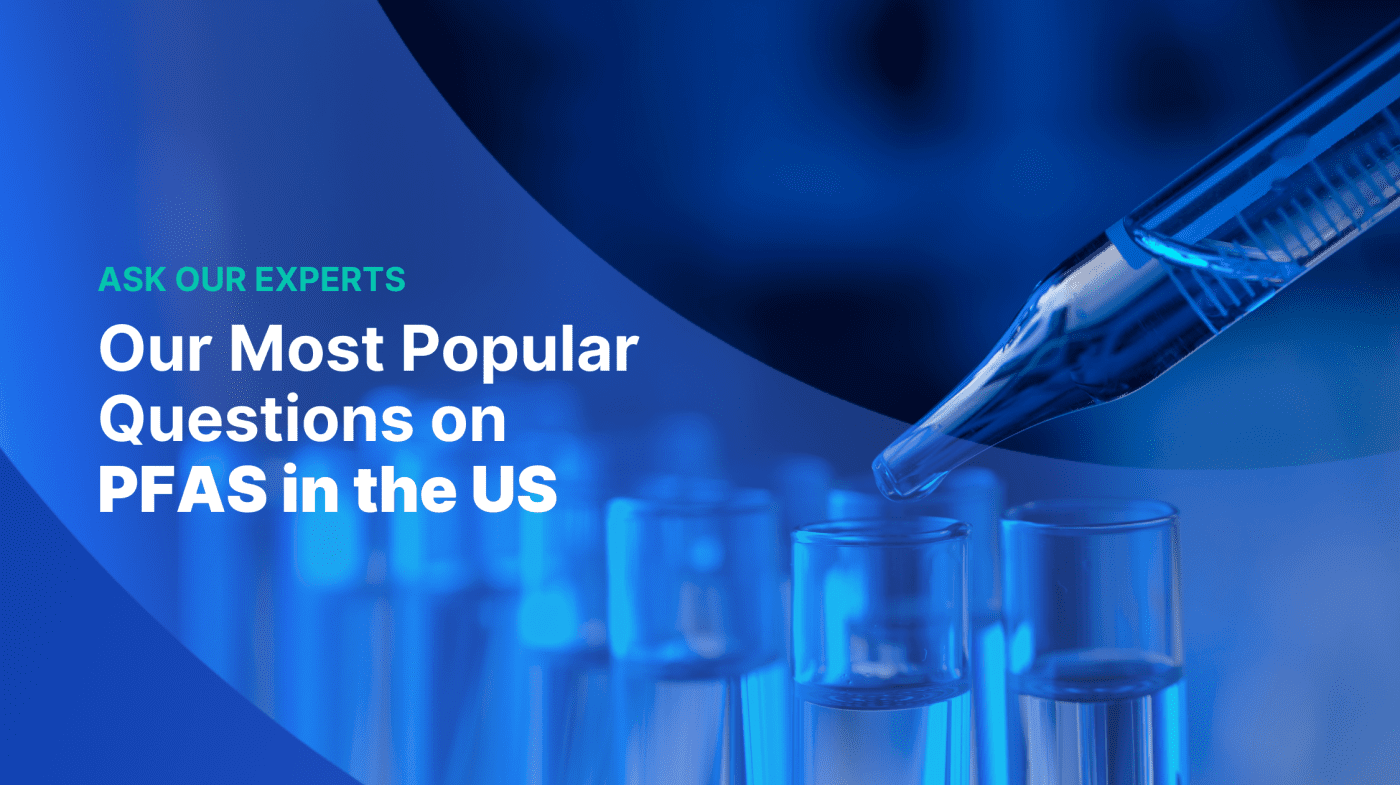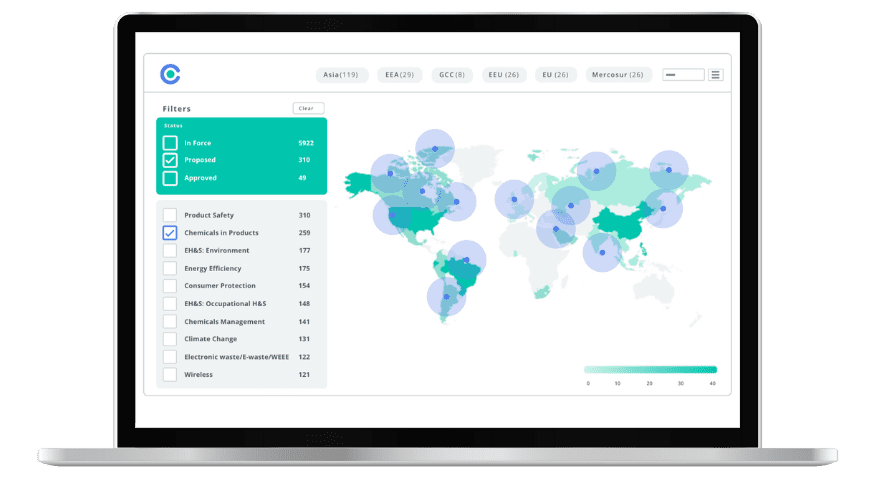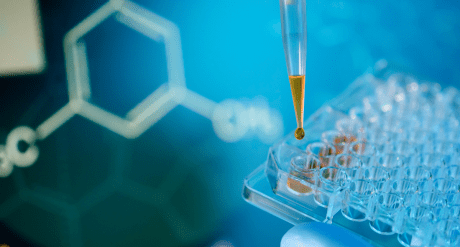
Ask Our Experts: Our Most Popular Questions on PFAS in the US

This blog was originally posted on 27th May, 2025. Further regulatory developments may have occurred after publication. To keep up-to-date with the latest compliance news, sign up to our newsletter.
PFAS in the US
This Q&A tackles recent customer inquiries head-on, delving into the specifics of navigating U.S. PFAS regulations. We explore crucial topics such as Washington State’s Safer Products reporting for designated items, Minnesota’s proposed rules concerning PFAS in products under Amara’s Law (including reporting and fees), the interpretation of product exemptions in Maine, and the detailed reporting obligations for imported articles under TSCA Section 8(a)(7). If you’re seeking clarity on scope, responsible entities, and compliance deadlines, these targeted answers can help.
PFAS (Per- and Polyfluoroalkyl Substances) are under increasing regulatory scrutiny across the United States due to growing awareness of their environmental persistence and potential health impacts. This has led to a wave of new legislation, stricter rules, and heightened monitoring, creating a complex landscape for businesses. Many are now asking critical questions about how to navigate these evolving requirements.
Want to find out more about PFAS in the US? Check out our whitepaper ‘PFAS: United States Key Regulatory Developments‘.
Washington State PFAS Reporting: Understanding Safer Products Restrictions
Answered by Kelly Bugiera
Does Washington (USA): Safer Products Restrictions and Reporting for Designated Priority Products, Rule, May 2023 involve PFAS reporting requirements in Washington?
Applicable Regulations and Scope
Chapter 173-337, WAC Safer Products Restrictions and Reporting applies to a manufacturer of a priority consumer product that is required to submit a notification to Washington State Department of Ecology (Ecology), as listed in WAC 173-337-110, 173-337-112, and 173-337-114. Per this list, 173-337-110 contains requirements for PFAS.
If so, can you please advise a copy or capture of related clauses from the regulation for the requirement, scope, and date?
Covered Product Categories for PFAS Requirements
WAC 173-337-110 is broken up into four subsections, each covering specific types of products for which there are requirements for PFAS. These subsections include:
(1) Aftermarket stain- and water-resistance treatments.
(2) Carpets and rugs.
(3) Leather and textile furniture and furnishings intended for indoor use.
(4) Leather and textile furniture and furnishings intended for outdoor use.
You would need to comply with these requirements for PFAS if you are distributing any of the aforementioned products.
Reporting Exemptions and Rebuttal for Certain Products
Regarding reporting, if you are distributing a product listed in (1), (2) or (3) from the list you are not required to report. However, manufacturers may rebut the presumption that “the detection of total fluorine indicates the intentional addition of PFAS” by submitting a statement to Ecology that includes the following information:
- Name and address of the person submitting the statement;
- Statement that PFAS were not intentionally added, providing credible evidence supporting this statement and including information, data, or sources relevant to show PFAS were not intentionally added.
Specific Reporting for Outdoor Leather and Textile Goods
For (4) of the list above (leather and textile furniture and furnishings intended for outdoor use), there are specific reporting requirements. The manufacturer must provide notice to Ecology that covered leather and textile furniture and furnishings intended for outdoor use contains intentionally added PFAS (in accordance with WAC 173-337-060). As specified for products (1)-(3) in the list above, Ecology presumes that the detection of total fluorine indicates the intentional addition of PFAS. Manufacturers may also rebut this presumption by submitting a statement to Ecology that includes:
- Name and address of the person submitting the statement;
- Statement that PFAS were not intentionally added, providing credible evidence supporting that statement and including information, data, or sources relevant to demonstrate that PFAS were not intentionally added.
Key Dates and Deadlines
The reporting requirements for leather and textile furniture and furnishings intended for outdoor use took effect on January 1, 2024. The reporting party is required to submit a notification to Ecology by January 31, 2025, and annually thereafter by January 31st.
Minnesota PFAS Rules: Scope of Amara’s Law for Electronics and Fees
Answered by Kelly Bugiera
With regard to the regulatory update titled ‘Minnesota (USA) – Proposed Rules re: PFAS in Products – Reporting and Fees‘: are collection of information and new fees only applicable to products listed under “Amara’s Law”?
Link to Amara’s Law and Reporting Mandate
These are the draft rules associated with Minnesota Statutes Sec. 116.943 (also known as Amara’s Law). Per the statutes, on or before January 1, 2026, a manufacturer of a product sold, offered for sale, or distributed in Minnesota, that contains intentionally added PFAS, must submit the specified reporting information. The main purpose of this proposed rulemaking is to establish a program for the Minnesota authorities to collect information about products containing intentionally added PFAS, as directed by Amara’s Law. This proposed rulemaking also creates a fee to be paid upon submission of the required reporting information about products containing intentionally added PFAS.
So, electronics (e.g. printers) are out of scope?
Link to Amara’s Law and Reporting Mandate
These are the draft rules associated with Minnesota Statutes Sec. 116.943 (also known as Amara’s Law). Per the statutes, on or before January 1, 2026, a manufacturer of a product sold, offered for sale, or distributed in Minnesota, that contains intentionally added PFAS, must submit the specified reporting information. The main purpose of this proposed rulemaking is to establish a program for the Minnesota authorities to collect information about products containing intentionally added PFAS, as directed by Amara’s Law. This proposed rulemaking also creates a fee to be paid upon submission of the required reporting information about products containing intentionally added PFAS.
Definition of ‘Products’ and Scope Inclusions
These reporting requirements apply to “products” which are defined as items that are manufactured, assembled, packaged, or otherwise prepared for sale to consumers. This definition includes, but is not limited to, product components, sold or distributed for personal, residential, commercial, or industrial use, including for use in making other products. There is no specific exemption from reporting requirements for electronics such as printers.
Waiver Provisions
For these reporting requirements that are referenced in the proposed rules, there is a provision stating that the Commissioner may waive all or part of these requirements if it is determined that substantially equivalent information is already publicly available. The Commissioner may grant a waiver to a manufacturer or a group of manufacturers for multiple products or a product category.
Exemptions to Reporting Requirements
Aside from the possibility of a waiver from the reporting requirements in certain circumstances, Section 116.943 does not apply to:
- A product for which federal law governs the presence of PFAS in the product in a manner that preempts state authority;
- Firefighting foam or food packaging that is regulated for PFAS elsewhere in Minnesota state law; or
- The sale or resale of a used product.
Maine PFAS Restrictions: Interpreting Exemptions for Public Health and Environmental Testing
Answered by Victoria Smart
Maine (USA): Restriction of Products Containing Perfluoroalkyl and Polyfluoroalkyl (PFAS) Substances, House Paper 1113, Legislative Document 1503 Enacted, 2021 specifies an exemption for products “developed or manufactured for purposes of public health, environmental or water quality testing.” The exact scope of this exemption is not clear, other than products for water quality testing. Is there anywhere in Maine law or state agency rules where definitions are given products developed or manufactured for purposes of public health or environmental?
Interpreting “Public Health Toolbox”
Within the text of the bill, the terms “developed or manufactured for purposes of public health, environmental or water quality testing” would be essentially referring to a “public health toolbox”. The terms suggest it may be a curated set of resources designed for public health purposes – and specifically the testing of an environment or environments, and/or water and its quality, both of which generally have an effect on the public.
How do your experts interpret the phrase “developed or manufactured for purposes of public health, environmental or water quality testing”?
Scope Considerations and Manufacturer Responsibility
Such a scope could be difficult to describe exactly. This description would appear to curb a manufacturer’s responsibility for establishing the scientific and health basis, as opposed to consumer products. The phrase “purposes of public health’ also leans toward the public good.
Minnesota PFAS Reporting Under Amara’s Law: Identifying the Responsible Entity
Answered by Kelly Bugiera
In relation to Minnesota (USA): Reporting and Fees on Per- and Polyfluoroalkyl (PFAS) in Products, Draft Rules Chapter 7026, April 2025, which entity would be required to report?
Manufacturer Reporting Obligation
Per Amara’s Law (116.943 of 2024 Minnesota Statutes, Products Containing PFAS), Subdivision 2 states that, on or before January 1, 2026, a manufacturer of a product sold, offered for sale, or distributed in Minnesota, that contains intentionally added PFAS, must submit the specified information.
Defining “Manufacturer”
According to the definitions included in Subdivision 1 of this Law, a “manufacturer” is defined as the person that creates or produces a product or whose brand name is affixed to the product.
Responsibility for Imported Products
However, in the case of a product imported into the United States, “manufacturer” includes the importer or first domestic distributor of the product if the person that manufactured or assembled the product, or whose brand name is affixed to the product, does not have a presence in the United States.
These are the details provided in the law, as far as responsible party. Based on this definition, I hope this helps to provide you with the information you need to determine the legal entity that should be reporting for you.
TSCA Section 8(a)(7) PFAS Reporting: Clarifying Requirements for Imported Articles
Answered by Kelly Bugiera
Seeking clarification on the Updated Instructions for Reporting PFAS Under TSCA Section 8(a)(7) in relation reporting using the PFAS in Imported Articles streamlined form. Regarding the Preparation of Reports, if a manufacturer imports articles containing PFAS into the United States every year between 2011 and 2022 is the manufacturer required to prepare annual reports for the reportable PFAS used each year or do they need to prepare a report for the reportable PFAS used between 2011 and 2022 together?
Guidance from 40 CFR 705.18
For your questions about the streamlined reporting for imported articles containing PFAS, additional information is provided in 40 CFR 705.18. Paragraph (a) contains the information which a manufacturer, who has imported a PFAS in an article, must report (to the extent they know or can reasonably know).
Regarding the Reporting of Quantities of PFAS-Containing Articles Imported do manufacturers need to report the amount of imported articles containing PFAS each year? Is it okay to submit a report summarizing the quantity of imported articles containing PFAS for the entire period?
Annual Reporting Requirements Since 2011
40 CFR 705.18(a) states that if you qualify to use a streamlined reporting form for PFAS in an imported article, then for each year since January 1, 2011, in which the PFAS was imported in an article, information must be submitted. Information requested on the streamlined reporting form for article importers includes chemical-specific information for each chemical substance that is a PFAS imported in an article, for each year since January 1, 2011.
Reporting Categories of Use and Concentration Annually
Additionally, for each year since January 1, 2011, it would be necessary to report specified information on categories of use of each PFAS imported in an article. This includes estimated maximum concentration. For each year where the PFAS in an imported article is used in consumer or commercial products, the submitter must report the estimated typical maximum concentration, as specified.
Hopefully, the information in 40 CFR 705.18 can help you assess the steps that would need to be taken for streamlined reporting.
Stay Ahead Of Regulatory Changes
Want to stay ahead of regulatory developments in PFAS in the US?
Accelerate your ability to achieve, maintain & expand market access for all products in global markets with C2P – your key to unlocking market access, trusted by more than 300 of the world’s leading brands.
C2P is an enterprise SaaS platform providing everything you need in one place to achieve your business objectives by proving compliance in over 195 countries.
C2P is purpose-built to be tailored to your specific needs with comprehensive capabilities that enable enterprise-wide management of regulations, standards, requirements and evidence.
Add-on packages help accelerate market access through use-case-specific solutions, global regulatory content, a global team of subject matter experts and professional services.
- Accelerate time-to-market for products
- Reduce non-compliance risks that impact your ability to meet business goals and cause reputational damage
- Enable business continuity by digitizing your compliance process and building corporate memory
- Improve efficiency and enable your team to focus on business critical initiatives rather than manual tasks
- Save time with access to Compliance & Risks’ extensive Knowledge Partner network

PFAS Under Pressure: Key Trends and Challenges Worldwide
Explore the growing global regulatory response to PFAS, driven by concerns over their persistence, bioaccumulation, and health risks.


![EU & UK Product Compliance - What's Hot in 2025 & Beyond [Website Banner]](https://www.complianceandrisks.com/app/uploads/2025/05/EU-UK-Product-Compliance-Whats-Hot-in-2025-Beyond-Website-Banner-460x224.jpg)